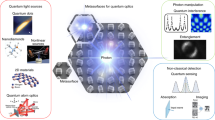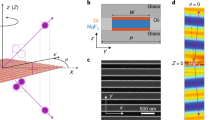Abstract
Metasurfaces mould the flow of classical light waves by engineering subwavelength patterns from dielectric or metallic thin films. We introduce and analyse a method in which quantum operator-valued reflectivity can be used to control both the spatiotemporal and quantum properties of transmitted and reflected light. Such quantum metasurfaces are realized by entangling the macroscopic response of atomically thin atom arrays to light. We show that such a system allows for parallel quantum operations between atoms and photons as well as for the generation of highly entangled photonic states such as photonic Greenberger–Horne–Zeilinger and three-dimensional cluster states suitable for quantum information processing. We analyse the influence of imperfections as well as specific implementations based on atom arrays excited into Rydberg states.
This is a preview of subscription content, access via your institution
Access options
Access Nature and 54 other Nature Portfolio journals
Get Nature+, our best-value online-access subscription
$29.99 / 30 days
cancel any time
Subscribe to this journal
Receive 12 print issues and online access
$209.00 per year
only $17.42 per issue
Buy this article
- Purchase on Springer Link
- Instant access to full article PDF
Prices may be subject to local taxes which are calculated during checkout




Similar content being viewed by others
Data availability
The data that support the findings of this study are available from the corresponding author upon reasonable request.
Change history
22 April 2020
A Correction to this paper has been published: https://doi.org/10.1038/s41567-020-0912-y
References
Bomzon, Z., Biener, G., Kleiner, V. & Hasman, E. Space-variant Pancharatnam–Berry phase optical elements with computer-generated subwavelength gratings. Opt. Lett. 27, 1141–1143 (2002).
Yu, N. et al. Light propagation with phase discontinuities: generalized laws of reflection and refraction. Science 334, 333–337 (2011).
Kildishev, A. V., Boltasseva, A. & Shalaev, V. M. Planar photonics with metasurfaces. Science 339, 1232009 (2013).
Chen, H.-T., Taylor, A. J. & Yu, N. A review of metasurfaces: physics and applications. Rep. Prog. Phys. 79, 076401 (2016).
Rubinsztein-Dunlop, H. et al. Roadmap on structured light. J. Opt. 19, 013001 (2016).
Kuznetsov, A. I., Miroshnichenko, A. E., Brongersma, M. L., Kivshar, Y. S. & Luk’yanchuk, B. Optically resonant dielectric nanostructures. Science 354, aag2472 (2016).
Li, G., Zhang, S. & Zentgraf, T. Nonlinear photonic metasurfaces. Nat. Rev. Mater. 2, 17010 (2017).
Khorasaninejad, M. & Capasso, F. Metalenses: versatile multifunctional photonic components. Science 358, eaam8100 (2017).
Krasnok, A., Tymchenko, M. & Alu, A. Nonlinear metasurfaces: a paradigm shift in nonlinear optics. Mater. Today 21, 8–21 (2018).
Yao, A. M. & Padgett, M. J. Orbital angular momentum: origins, behavior and applications. Adv. Opt. Photon. 3, 161–204 (2011).
Mathis, A. et al. Micromachining along a curve: femtosecond laser micromachining of curved profiles in diamond and silicon using accelerating beams. Appl. Phys. Lett. 101, 071110 (2012).
Schley, R. et al. Loss-proof self-accelerating beams and their use in non-paraxial manipulation of particles’ trajectories. Nat. Commun. 5, 5189 (2014).
Bekenstein, R., Schley, R., Mutzafi, M., Rotschild, C. & Segev, M. Optical simulations of gravitational effects in the Newton–Schrödinger system. Nat. Phys. 11, 872–878 (2015).
Bettles, R. J., Gardiner, S. A. & Adams, C. S. Enhanced optical cross section via collective coupling of atomic dipoles in a 2D array. Phys. Rev. Lett. 116, 103602 (2016).
Shahmoon, E., Wild, D. S., Lukin, M. D. & Yelin, S. F. Cooperative resonances in light scattering from two-dimensional atomic arrays. Phys. Rev. Lett. 118, 113601 (2017).
Zhou, M., Liu, J., Kats, M. A. & Yu, Z. Optical metasurface based on the resonant scattering in electronic transitions. ACS Photonics 4, 1279–1285 (2017).
Facchinetti, G. & Ruostekoski, J. Interaction of light with planar lattices of atoms: reflection, transmission and cooperative magnetometry. Phys. Rev. A 97, 023833 (2018).
Wang, B., Zhao, C., Kan, Y. & Huang, T. Design of metasurface polarizers based on two-dimensional cold atomic arrays. Opt. Exp. 25, 18760–18773 (2017).
Wang, K. et al. Quantum metasurface for multiphoton interference and state reconstruction. Science 361, 1104–1108 (2018).
Stav, T. et al. Quantum entanglement of the spin and orbital angular momentum of photons using metamaterials. Science 361, 1101–1104 (2018).
Guimond, P.-O., Grankin, A., Vasilyev, D. V., Vermersch, B. & Zoller, P. Subradiant Bell states in distant atomic arrays. Phys. Rev. Lett. 122, 093601 (2019).
Weiner, A. M. Femtosecond pulse shaping using spatial light modulators. Rev. Sci. Instrum. 71, 1929–1960 (2000).
Saffman, M., Walker, T. G. & Mølmer, K. Quantum information with Rydberg atoms. Rev. Mod. Phys. 82, 2313 (2010).
Barredo, D. et al. Demonstration of a strong Rydberg blockade in three-atom systems with anisotropic interactions. Phys. Rev. Lett. 112, 183002 (2014).
Browaeys, A., Barredo, D. & Lahaye, T. Experimental investigations of dipole–dipole interactions between a few Rydberg atoms. J. Phys. B 49, 152001 (2016).
Knill, E., Laflamme, R. & Milburn, G. J. A scheme for efficient quantum computation with linear optics. Nature 409, 46–52 (2001).
Raussendorf, R., Browne, D. E. & Briegel, H. J. Measurement-based quantum computation on cluster states. Phys. Rev. A 68, 022312 (2003).
Duan, L.-M. & Kimble, H. Scalable photonic quantum computation through cavity-assisted interactions. Phys. Rev. Lett. 92, 127902 (2004).
Kimble, H. J. The quantum internet. Nature 453, 1023–1030 (2008).
Varnava, M., Browne, D. E. & Rudolph, T. Loss tolerance in one-way quantum computation via counterfactual error correction. Phys. Rev. Lett. 97, 120501 (2006).
Pastawski, F., Yoshida, B., Harlow, D. & Preskill, J. Holographic quantum error-correcting codes: toy models for the bulk/boundary correspondence. J. High Energy Phys. 2015, 149 (2015).
Grankin, A., Guimond, P., Vasilyev, D., Vermersch, B. & Zoller, P. Free-space photonic quantum link and chiral quantum optics. Phys. Rev. A 98, 043825 (2018).
Saffman, M. & Walker, T. Creating single-atom and single-photon sources from entangled atomic ensembles. Phys. Rev. A 66, 065403 (2002).
Schön, C., Solano, E., Verstraete, F., Cirac, J. I. & Wolf, M. M. Sequential generation of entangled multiqubit states. Phys. Rev. Lett. 95, 110503 (2005).
Lindner, N. H. & Rudolph, T. Proposal for pulsed on-demand sources of photonic cluster state strings. Phys. Rev. Lett. 103, 113602 (2009).
Schwartz, I. et al. Deterministic generation of a cluster state of entangled photons. Science 354, 434–437 (2016).
Raussendorf, R., Harrington, J. & Goyal, K. Topological fault-tolerance in cluster state quantum computation. New J. Phys. 9, 199 (2007).
Jaksch, D. et al. Fast quantum gates for neutral atoms. Phys. Rev. Lett. 85, 2208 (2000).
Economou, S. E., Lindner, N. & Rudolph, T. Optically generated 2-dimensional photonic cluster state from coupled quantum dots. Phys. Rev. Lett. 105, 093601 (2010).
Barredo, D., De Léséleuc, S., Lienhard, V., Lahaye, T. & Browaeys, A. An atom-by-atom assembler of defect-free arbitrary two-dimensional atomic arrays. Science 354, 1021–1023 (2016).
Endres, M. et al. Atom-by-atom assembly of defect-free one-dimensional cold atom arrays. Science 354, 1024–1027 (2016).
Kim, H. et al. In situ single-atom array synthesis using dynamic holographic optical tweezers. Nat. Commun. 7, 13317 (2016).
Bernien, H. et al. Probing many-body dynamics on a 51-atom quantum simulator. Nature 551, 579–584 (2017).
Lienhard, V. et al. Observing the space-and time-dependent growth of correlations in dynamically tuned synthetic Ising models with antiferromagnetic interactions. Phys. Rev. X 8, 021070 (2018).
Omran, A. et al. Generation and manipulation of Schrödinger cat states in Rydberg atom arrays. Science 365, 570–574 (2019).
Covey, J. P. et al. Telecom-band quantum optics with ytterbium atoms and silicon nanophotonics. Phys. Rev. Appl. 11, 034044 (2019).
Rui, J. et al. A subradiant optical mirror formed by a single structured atomic layer. Preprint at https://arxiv.org/pdf/2001.00795.pdf (2020).
Li, L., Dudin, Y. & Kuzmich, A. Entanglement between light and an optical atomic excitation. Nature 498, 466–469 (2013).
Cooper, A. et al. Alkaline-earth atoms in optical tweezers. Phys. Rev. X 8, 041055 (2018).
Bloch, I. Ultracold quantum gases in optical lattices. Nat. Phys. 1, 23–30 (2005).
Yu, N. et al. A broadband, background-free quarter-wave plate based on plasmonic metasurfaces. Nano Lett. 12, 6328–6333 (2012).
Estakhri, N. M., Edwards, B. & Engheta, N. Inverse-designed metastructures that solve equations. Science 363, 1333–1338 (2019).
Lang, J., Chang, D. E. & Piazza, F. Interaction-induced transparency for strong-coupling polaritons. Preprint at https://arxiv.org/pdf/1810.12912.pdf (2018).
J. Lang, J., Chang, D. E. & Piazza, F. Non-equilibrium diagrammatic approach to strongly interacting photons. Preprint at https://arxiv.org/pdf/1810.12921.pdf (2018).
Zhou, Y. et al. Probing dark excitons in atomically thin semiconductors via near-field coupling to surface plasmon polaritons. Nat. Nanotechnol. 12, 856–860 (2017).
Scuri, G. et al. Large excitonic reflectivity of monolayer MoSe2 encapsulated in hexagonal boron nitride. Phys. Rev. Lett. 120, 037402 (2018).
Acknowledgements
We thank D. Oren and A. Omran for helpful discussions. This work was supported by the National Science Foundation (NSF), the Center for Ultracold Atoms, the Air Force Office of Scientific Research via the Multidisciplinary University Research Initiative and the Vannevar Bush Faculty Fellowship. R.B., I.P. and H.P. are supported by the NSF through a grant for the Institute for Theoretical Atomic, Molecular and Optical Physics at Harvard University and the Smithsonian Astrophysical Observatory. I.P. also acknowledges funding by Society in Science, The Branco Weiss Fellowship, administered by the ETH Zurich.
Author information
Authors and Affiliations
Contributions
The theoretical analysis and numerical analysis were carried out by R.B. All authors contributed to the development of theoretical tools, discussed the results and contributed to the manuscript. The manuscript was written by R.B., H.P. and M.D.L.
Corresponding author
Ethics declarations
Competing interests
The authors declare no competing interests.
Additional information
Publisher’s note Springer Nature remains neutral with regard to jurisdictional claims in published maps and institutional affiliations.
Supplementary information
Supplementary Information
Supplementary analysis, Fig. 1 and discussion.
Rights and permissions
About this article
Cite this article
Bekenstein, R., Pikovski, I., Pichler, H. et al. Quantum metasurfaces with atom arrays. Nat. Phys. 16, 676–681 (2020). https://doi.org/10.1038/s41567-020-0845-5
Received:
Accepted:
Published:
Issue Date:
DOI: https://doi.org/10.1038/s41567-020-0845-5
This article is cited by
-
Light–matter interactions in quantum nanophotonic devices
Nature Reviews Physics (2024)
-
Superradiant and subradiant states in lifetime-limited organic molecules through laser-induced tuning
Nature Physics (2024)
-
A switchable atomic mirror
Nature Physics (2023)
-
Enabling smart vision with metasurfaces
Nature Photonics (2023)
-
A subwavelength atomic array switched by a single Rydberg atom
Nature Physics (2023)



